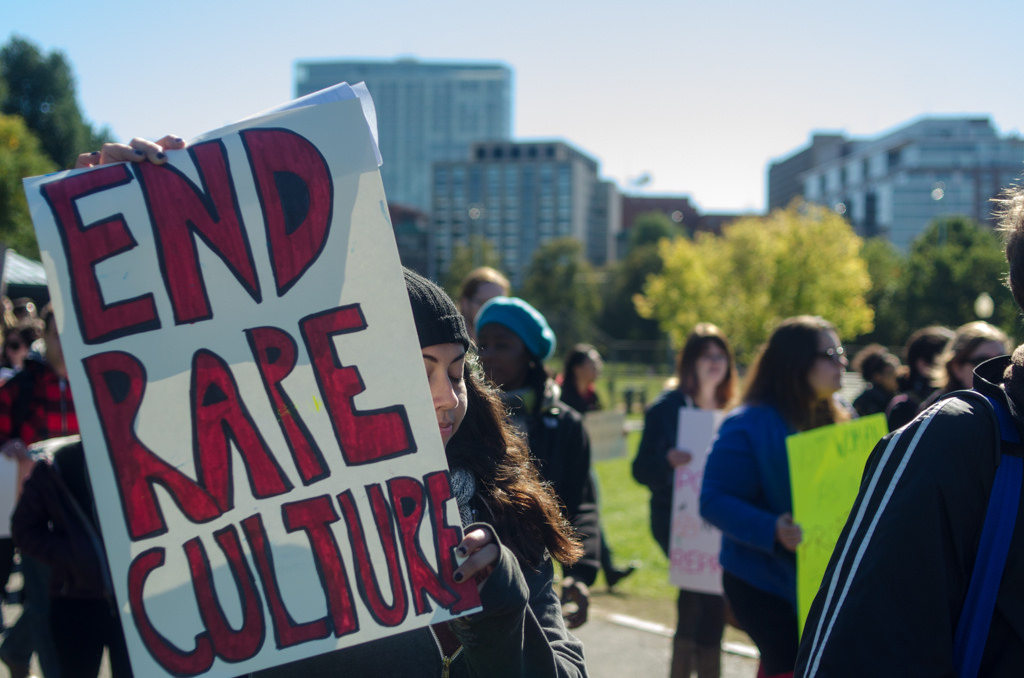Feminism 101: What is Rape Culture?

Image: “March Against Rape Culture and Gender Inequality – 2” by Chase Carter via Flickr / CC BY-ND 2.0.
Over the past few years, the concept of rape culture appears to have reached the minds and mouths of average Americans and has spurred a great deal of debate. While this discourse is important and may bring about positive social changes, the misconceptions and misunderstanding of the topic limit such changes.
So now you may be asking, what is rape culture exactly?
According to the WAVAW Rape Crisis Centre, rape culture consists of beliefs and cultural norms which support violence against women through victim blaming and normalizing male sexual aggression.
In addition to this, rape culture is centered around a heteronormative narrative, meaning heterosexuality is unconsciously prioritized as the most normal and acceptable sexual orientation and non-heterosexual narratives are often ignored. This subsequently promotes a power structure in which straight, cisgender men are on top, and straight, cisgender women are below them.
Those who don’t fall into either of these categories are left at the bottom of the structure and are thought to be “broken,” but “fixable” through heterosexual sexual behaviors. The logic behind this may posit that a queer woman is only attracted to other women until you force her to have sex with a man. This heterosexual act will cure her of her homosexuality, even if there’s no empirical data to suggest that this does anything except traumatize her.
If you’re wondering if you live in a society with an existing rape culture, ask yourself if you see or hear the following in your day-to-day life:
- Rigid gender norms (based on the hypersimplistic gender binary) restrict expression that contradict the heteronormative narrative. As a result, genderqueer, gender rebel, or otherwise non-conforming people face disproportionate rates of violence.
- Girls are taught that violence is an indication of romantic feelings, so if a boy punches a girl on the playground, pulls her hair, or calls her names, that just means he likes her and that “boys will be boys”.
- Women are commonly expected to graciously accept catcalling and casual sexual harassment as compliments toward their appearance. While these comments are sometimes regarded as nothing more than flattery, they are part of a culture that bolsters heterosexual male dominance in almost every social space.
- People are taught how to not get raped, but not that they shouldn’t rape. Rather than attempting to stop the act from ever happening, victims and survivors are blamed for being attacked. This not only misplaces the responsibility, but is largely ineffective in lowering the rate of rape in the U.S.
- There is an entire industry of whistles, smartphone apps, and various forms of weaponry dedicated to ensuring that women don’t get raped. By making victims accountable their assaults, the actual issue, rapists, are never addressed.
- It is considered a norm that one in four college-aged women, one in six adult women, and one in 33 men will be victims of sexual assault. These occurrences are also more common among trans women, whose rate of experiencing sexual violence is one in three, and trans men whose rate is one in six.
- Young men have openly chanted about committing rape, as seen at Yale University, University of Central Florida, and St. Mary’s University. This is reflective of the normalization of rape and is indicative of the culture’s tendency to allow such behaviors, so long as the offender admits some amount of guilt.
- Rape is considered a rare occurrence that only happens to women, even though there is known statistical evidence that disproves this. Misconceptions such as this only further marginalize those who identify outside the gender binary and trivialize cases where men are assaulted.
- People believe rape is a corrective method for curing homosexuality. This creates a justification for rape through the villainization of non-heterosexual behaviors.
- A victim of rape is frequently doubted and blamed for being attacked. This kind of reaction is regarded as a form of gaslighting, or twisting information to favor an abuser and make a victim doubt their own perception, memory, or sanity.
- Being accused of rape is often seen as worse than actually being raped, because it could “destroy someone’s life.” Once again, this kind of mentality propagates rape culture by sympathizing with the perpetrator and blaming the victim for being assaulted.
What is central to all of these social practices and behaviors is that they produce fear. If you are able to observe fear in people, such that everyday activities like walking down the street are considered dangerous, it is likely that you are living in a rape culture.




